Web Integration with Visual Studio .NET and ASP.NET
There is no shortage of options to integrate Crystal Reports 10 reports into web applications. As discussed earlier in this chapter, both the Report Designer Component and Crystal Enterprise Embedded Edition allow single- tier integration of existing Crystal reports into web pages. And, the rest of Part II of this book discusses the full Crystal Enterprise editions that also can be used to host reports entirely in a web environment. That leaves another development and integration environment to be discussed: Visual Studio .NET and ASP.NET.
Crystal Reports has played a prominent role in Microsoft development environments in the recent past. Crystal Reports has been bundled with previous versions of Microsoft Visual Studio products (perhaps with the sole exception being the concentration on the Microsoft Report Designer included with Visual Studio 6 ”Crystal Reports was still available separately on the program CD). With Visual Studio .NET (VS.NET), Crystal Reports has once again taken on a prominent role, being an integral part of the VS.NET package right out of the box.
| Note | This portion of the book concentrates on the finer points of Crystal Reports integration with Visual Studio .NET using Visual Basic coding techniques. The material assumes you already have a fundamental knowledge of Visual Studio .NET architecture and coding techniques. This portion of the book will not teach you VS.NET fundamentals. |
Crystal/VS.NET Bundle Options
The first distinction to make is between Crystal Reports features bundled with the core Microsoft VS.NET package, and those that are added on by a Crystal Reports 10 purchase. If you purchase a copy of Microsoft Visual Studio .NET 2003, Crystal Reports is bundled with the VS.NET package. Simply ensure that it is selected when you initially install the VS.NET package to ensure that Crystal Reports features will be available. If you discover that you didn t initially install Crystal Reports, simply rerun VS.NET setup from the Windows Control Panel and select the Crystal Reports option. This will install the core Crystal Reports bundle that provides most all of the Crystal Reports capabilities you ll need from within a .NET application.

This installs the .NET bundled version of Crystal Reports, consisting of the Crystal help collection added to the combined VS.NET help collection; and necessary assemblies for designing a report within the VS.NET IDE, integrating the report with a web or Windows application, and creating a Crystal Report web service. This will not install a stand-alone copy of Crystal Reports that allows you to design reports outside of the VS.NET IDE.
The version of Crystal Reports installed with VS.NET falls in between Crystal Reports versions 8.5 and 9. While this version will create an .RPT file that can be used outside of VS.NET, it cannot be used with Crystal Reports 8.5 or earlier, as it makes use of the new version 9 .RPT file format that is not backward compatible. However, these .RPT files can be opened and manipulated with stand-alone versions of Crystal Reports 9 or later.
The object models exposed by the bundled version of Crystal Reports are fairly full- featured, but not equal in flexibility to that supplied with the COM-compliant Report Designer Component (discussed earlier in this chapter and in Chapter 27). And, some features and procedures with the bundled version require extra coding steps to navigate through more complex sets of objects than are available with the object model installed with Crystal Reports 10 Developer or Advanced Developer editions.
If you install Crystal Reports 10 Developer or Advanced Developer editions, you ll find a .NET option within the Developer Components section of the custom installation option. Ensure that this is chosen when you install Crystal Reports 10. If you don t initially choose this option, rerun Crystal Reports setup from the program CD or the Windows Control Panel and choose the .NET option within the Developer Components category. You ll also need to rerun Setup and choose this option if you install (or re-install) VS.NET after you install Crystal Reports 10. Repairing a Crystal Reports 10 installation after re-installing VS.NET should also work.
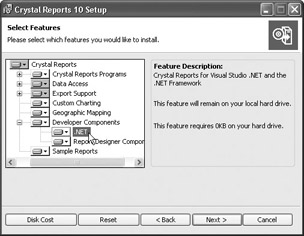
| Note | You may notice an Add .NET Components hyperlink from the initial startup screen that appears when you insert the Crystal Reports 10 program CD. Unfortunately, when you click this link, only a message will appear indicating that .NET components are installed from the actual setup program. You ll need to ensure that the proper option from the Developer Components section of the setup program is selected to install the extra version 10 .NET components. |
Installing Crystal Reports 10 Developer or Advanced Developer Edition will supplement the existing Crystal Reports assemblies installed with VS.NET with newer versions that contain additional capabilities. While not an exhaustive list, these version 10 enhancements include some simpler object model calls to perform various report integration functions, an ActiveX printing control for web forms, additional report datasources, and support for reporting from CE Embedded Edition/RAS and the full versions of Crystal Enterprise. An additional help collection will also be added to the combined VS.NET help collection. You ll notice, in many cases, Crystal- related help options for both Crystal Reports and Crystal Reports 10.
Also, you ll be able to create reports in the stand-alone copy of Crystal Reports 10, including the interactive design/preview process, which will probably be a vast improvement over the VS.NET IDE report designer that doesn t provide the quick design/preview paradigm that stand-alone Crystal Reports does. You may then merely import your finished .RPT file into VS.NET for integration.
| Note | Many of the examples in this chapter are taken from a sample VS.NET web application that can be downloaded from CrystalBook.com, this book s companion web site. These examples have been developed with Crystal Reports Advanced Developer Edition installed. As such, some object model calls demonstrated require the additional capabilities of Crystal Reports 10. These are noted in the sample code and in the book. |
Web Forms Viewer
The first concept you may need to become familiar with when integrating a Crystal report into a web application with VS.NET is the separation between the actual report itself (the .RPT file you either create within the VS.NET IDE or add to it after creating in the Crystal Reports designer) and the HTML-based viewer that actually shows the report to the web user in a browser. If you are going to include a Crystal Report in a web page as part of your application, you ll need to pay close attention to these two distinct objects. If, however, you only wish to include a report in a web-based application for the purpose of exporting to an external file (perhaps placing the exported report on the web server for later download or sharing somewhere else within the web server s network), then you may not even need to add a viewer that presents the report online in a browser.
However, since most web-based applications that include a Crystal report will probably need to present the report to a user in their web browser, you ll immediately need to determine how to present the report to the viewer in a properly rendered HTML format. For this, VS.NET includes the Crystal Web Forms Viewer. By dropping a Crystal Web Forms Viewer onto a web form, you can immediately display a Crystal report in a web browser, including all embedded formatting. This viewer also supports all typical Crystal Reports interaction, including page-on-demand viewing, group-tree navigation, report group drill-down, on- demand subreport interactivity, and report exporting and printing.
After creating an ASP.NET application (the language you use to create it is irrelevant ” Crystal Reports is entirely language independent in VS.NET), add a Web Forms Viewer to the desired web form by dragging it from the Web Forms section of the Toolbox. A small outline will initially appear inside the web form and a set of properties specific to the Web Forms Viewer will appear in the Properties box. This is shown in Figure 22-2.
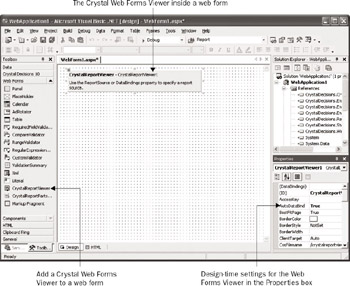
Figure 22-2: Crystal Web Forms Viewer in a Web Form
However, merely adding a Web Forms Viewer to a web form won t display anything when the application is run. This is because, as you may gather from the discussion earlier in the chapter on the two distinct part of a VS.NET Crystal Reports application, you must tie or bind an actual Crystal Report object to the Web Forms Viewer so that there s an actual report to view.
| Note | Crystal Reports can be integrated in VS.NET applications based on Visual Basic, C#, Managed C++, or other languages supported in the VS.NET development environment. This chapter, however, will concentrate on Visual Basic applications and will demonstrate Visual Basic coding techniques. |
Web Forms Viewer Binding Options
There are numerous ways to bind reports to the Web Forms Viewer. The option you choose depends largely on the way your application is designed ”whether your reports are external to your application (located on the web server at a specific file location or elsewhere on the web server s network connection), designed within the VS.NET IDE, or contained in a Report Component (discussed later), as well as whether you want to use Crystal s web report caching feature (also discussed later), and so forth.
Probably the simplest way to bind a report to the viewer is to specify the full pathname and filename of an .RPT file located on local or network drive. There are several ways to accomplish this:
-
Specify the viewer s ReportSource property Make sure the Crystal Web Forms Viewer is selected in the VS.NET IDE. Navigate to the ReportSource property in the Properties box. Click the down arrow and choose the Browse option. A file open dialog will appear. Navigate through drives and folders until you find the .RPT file you wish to display in the viewer.
-
Specify a filename in the DataBindings dialog box Make sure the Crystal Web Forms Viewer is selected in the VS.NET IDE. Navigate to the (DataBindings) property (typically, the first property in the Properties box). Click the ellipses button to display the DataBindings dialog box. Choose the ReportSource property in the Bindable Properties list. Click the Custom Binding Expression radio button and type the full pathname and filename into the box below the radio button, surround the filename with quotation marks.
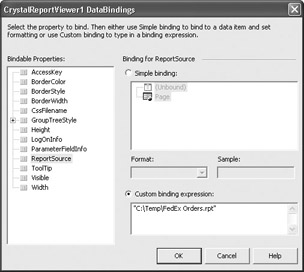
-
Set the viewer s ReportSource property in code The report can be bound at run time by specifying the Crystal Web Forms Viewer s ReportSource property. For example, if you display the code window for the web form containing the viewer (perhaps the Page_Load event), specify the viewer s ReportSource property as follows :
Private Sub Page_Load(ByVal sender As System.Object, _
ByVal e As System.EventArgs) Handles MyBase.Load
'Put user code to initialize the page here
CrystalReportViewer1.ReportSource = "C:\Temp\FedEx Orders.rpt"
End Sub
If you bind the report with either the ReportSource property in the Properties box or the custom binding expression in the DataBind dialog box, the report will actually be displayed in the Crystal Web Forms Viewer in the VS.NET IDE. If you specify the viewer s ReportSource property in code, the viewer will retain its smaller footprint with no report display inside the web form at design time. However, in any event, when you run the web application, the web form will display the report in a web browser (you may be prompted for database credentials or parameter values first).
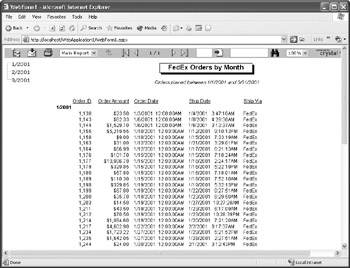
| Note | The Crystal Reports 10 Web Forms Viewer includes the AutoDataBind property, which is set to True by default. If, for some reason, you choose to set this property to False at design time, or you are using an older Crystal Web Forms Viewer that doesn t include the AutoDataBind property, you must data-bind the viewer at run time by executing the viewer s DataBind method after the InitializeComponent procedure that s executed in the web form s Page_Init event. Private Sub Page_Init(ByVal sender As System.Object, _ |
You may also want to bind a report you ve created within the VS.NET IDE to a report viewer (the integrated report designer is discussed later in the chapter, under Integrated Report Designer ). Or, you may wish to add an existing .RPT file to your web project and bind it to a viewer. These types of reports that reside in your project are known as strongly typed reports, and a class is added to the project for each strongly typed report. In these cases, you ll eventually see an .RPT filename in the Solution Explorer that represents the strongly typed report you want to bind to the viewer. Surprisingly, though, if you attempt to set the viewer s ReportSource property to the .RPT filename, you won t find the file in the drop-down list of available options ”either in the Properties box or in the DataBindings dialog box.
This strongly typed report can be bound using a single line of code in the web form s Page_Load event. By setting the viewer s ReportSource property to a new instance of the desired report class (sans the .RPT extension), you can bind the viewer to the report included in the project.
'Binds strongly-typed CrystalReport1.RPT file from Solution Explorer
CrystalReportViewer1.ReportSource = New CrystalReport1
You can also bind the viewer to a cached version of the strongly typed report. By caching the report, you may improve performance when multiple users access the same web page that contains the report viewer. Whenever you add a strongly typed report to a web project, a cached class of the same report is also created, which can be bound to the Web Forms Viewer.
'Binds cached CrystalReport1.RPT file from Solution Explorer
CrystalReportViewer1.ReportSource = New CachedCrystalReport1
| Note | Cached reports are only supported in ASP.NET web applications (not Windows applications). By caching a report, you can potentially improve performance by storing recently viewed report data on the web server for additional users that access the same web form within the prescribed cache time. If, however, you are using a very fluid transactional database that changes frequently, you may choose not to use cached reports in order that a report viewer will always see the most current set of data. |
You may also wish to bind a report to the Crystal Web Forms Viewer via a strongly typed report component. In this situation, you add an additional component to the web form from the Toolbox and choose an existing strongly typed report in the project for the component to host. Begin by dragging the ReportDocument from the Components area of the Toolbox to the web form. Once you ve dropped it on the form, the Choose a ReportDocument dialog box will appear. Click the drop-down list and choose the desired report from the list (you ll see strongly typed reports you ve already added to your project). If you wish to cache the report, check the appropriate box.
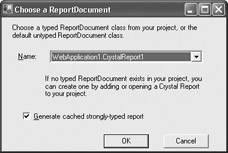
Once you click OK, the report component will appear in a design time “only area of the web form (it will not be visible at run time). You may then merely select the Crystal Web Forms Viewer in the form and click the drop-down list for the ReportSource property in the Properties box. You ll see all report components you ve added to the form in the list. Choose the desired component. Or, you can click the ellipses next to the viewer s (DataBindings) property in the Properties box. Then, select ReportSource in the Bindable Properties list, click the Simple Binding radio button, and expand the Page category. Select the desired report component from the expanded list.
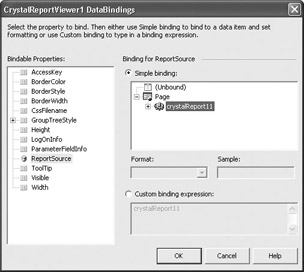
| Tip | There are yet additional ways of binding reports to viewers. A complete discussion of all Web Forms Viewer binding options, including sample code, can be found in VS.NET help. Search for Report Binding Options for Web Forms Viewers . There are also additional samples and examples of report binding that can be downloaded from support.BusinessObjects.com or www.BusinessObjects.com/DevZone. |
Integrated Report Designer
One of the more exciting integration benefits of Crystal Reports and Microsoft development environments is the Integrated Report Designer. This feature was originally introduced with the Report Designer Component and Visual Basic 6 (covered in Part III of this book). As Microsoft chose Crystal Reports for its integrated reporting tool in Visual Studio .NET, this capability is brought into the VS.NET environment as well. With this design tool built into the VS.NET IDE, you can perform complex report design tasks , such as adding and joining tables, adding fields, grouping records, and formatting objects, much the same way as you can with the full Crystal Reports designer in an off-the-shelf version of Crystal Reports. When you are finished, the .RPT file you ve created or modified will exist within the project as a strongly typed report.
| Note | One of the initial decisions you ll be making is whether to create reports in the VS.NET IDE or in stand-alone Crystal Reports. While VS.NET allows you to create reports without buying a stand-alone copy of Crystal Reports, your report design choices are more limited in the Integrated Report Designer. For example, you can t simply click a Preview button to see what your finished report looks like ”you must place the report in a viewer and run the application every time you want to see any design changes. This, and other differences, may lead you to actually do most of your report design in a stand-alone copy of Crystal Reports and then add the .RPT file to your project with Add Add Existing Item. |
If you ve already worked on another report (perhaps with the full stand-alone copy of Crystal Reports or another VS.NET application), you can add it to your existing project. Simply right-click on the project name in the Solution Explorer and choose Add Add Existing Item from the pop-up menu. An open file dialog box will appear. Change the file type in the drop-down list to Crystal Report ”only .RPT files will then appear in the dialog box. Navigate to the location for your desired report and open it. It will be added to the Solution Explorer. To edit the report, simply double-click it in the Solution Explorer window. The report will appear in its own tab in the VS.NET IDE inside the Integrated Report Designer.
| Note | Adding an existing report to your project will make a copy of the report in your project folder. Any modifications you make to this report in the Integrated Report Designer won t affect the original report you chose when you added the item. |
If you wish to create a new report from scratch for design in the Integrated Report Designer, begin by selecting the project name in the Solution Explorer. Right-click and choose Add Add New Item from the pop-up menu. The Add New Item dialog box will appear. If necessary, scroll through the available items until you find the Crystal Report icon. Once you select it, a default filename will appear at the bottom of the dialog box. Either accept it or type the desired filename in before clicking Open.

A new tab will appear in the VS.NET IDE for the new Crystal Report, and the Crystal Report Gallery will appear, much as it does when you create a new report in stand-alone Crystal Reports. The Report Wizard and As a Blank Report radio buttons mimic their stand- alone Crystal Reports counterparts. However, the additional From an Existing Report choice appears only in the VS.NET Integrated Report Designer.
Choosing one of the report wizards will display the step-by-step report design dialogs discussed briefly in Chapter 1 of this book. If you choose As a Blank Report, an empty report canvas will appear in VS.NET (the Database Expert won t appear automatically, as it does when using the Blank Report option in stand-alone Crystal Reports). And, if you choose the From an Existing Report choice, an open file dialog will appear where you can navigate to an existing .RPT file to import into the VS.NET Integrated Report Designer.
Once you ve made your choices (and, in the case of a report wizard, proceeded through the necessary steps), your report will appear in the Integrated Report Designer inside the VS.NET IDE, as shown in Figure 22-3.
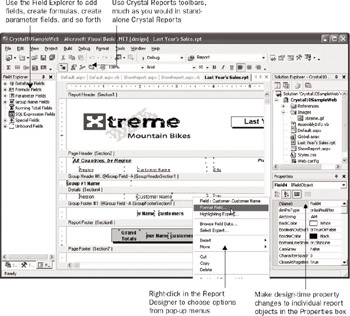
Figure 22-3: Integrated Report Designer in VS.NET IDE
Choosing a Datasource
If you are creating a new report from scratch in the Integrated Report Designer, you ll initially be presented with a blank design screen when you first create the report. As with most report design scenarios, the first step will be to choose a datasource to base your report on.
As with stand-alone Crystal Reports, this is done with the Database Expert. However, unlike stand-alone Crystal Reports, the Database Expert doesn t automatically appear when you first create a new report ”you need to display it by using a pop-up menu option. Ensure no existing report objects are selected and right-click in the report design area. Choose Database Database Expert from the pop-up menu. The Database Expert will appear.
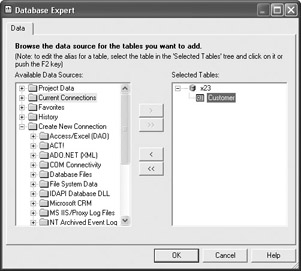
Choose the desired datasource category from the list. Note that the choice of categories (and choice of available datasource types) may vary, depending on whether you ve installed Crystal Reports 10 Developer or Advanced Developer editions ”additional datasources are made available when you do this. Also note that some datasources available in the stand- alone version of Crystal Reports, such as SQL Commands or Business Views stored in the Crystal Enterprise repository, won t be available in VS.NET. You will find a Project Data category, however, that will allow you to connect a report to an existing project datasource, as an ADO.NET dataset, that has already been defined in your project.
Choose the datasource (or datasources) that you wish to use for your report. You may be required to supply logon credentials to a server to make a connection. Expand the various datasource categories once you ve connected to choose individual tables, views, stored procedures, and so forth that you wish to use in your report. Add each desired table, view, or stored procedure to the Selected Tables list.
If you add more than one item to the Selected Tables list, the Links tab will appear in the Database Expert. Click it and link tables as described in Chapter 16. Once you ve correctly added and linked tables, close the Database Expert by clicking OK.
Selecting Records and Adding Field Objects
Once you ve added and linked tables or other datasources, you re ready to add field objects to the actual report canvas. You should also add record selection criteria to ensure that your report will be limited to a meaningful set of data records.
To limit the report to a certain set of records, use the Select Expert or the record selection formula. The Select Expert is displayed by right-clicking on a blank area of the report design canvas and choosing Report Select Expert from the pop-up menu. You can also click the Select Expert toolbar button in the Crystal Reports toolbar within the VS.NET IDE. If you prefer to edit the record selection formula using the Crystal formula language directly, choose Report Selection Formulas Record from the same pop-up menu as the Select Expert. The Formula Editor will appear where you can create or edit the report s record selection formula. Record Selection is covered in detail in Chapter 8.
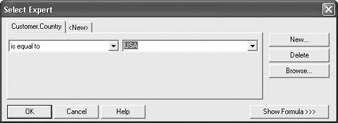
Add field objects to your report from the Field Explorer, which is initially docked at the left side of the report design window. These fields can consist of fields directly from your datasource, formulas that you create, parameter fields that prompt the report viewer for a value, and so forth. Expand the desired Field Explorer category and drag the desired field to the appropriate report section. You may also right-click a Field Explorer category, or an individual field, and choose options from the pop-up menu.
You can use the Field Explorer to create report formulas, parameter fields, and SQL Expressions (all are discussed in various chapters in Part I of this book). You can also drag and drop Special Fields, such as page numbers , print date and time, and so forth, to the report from the Special Fields category. The Unbound Fields category is unique to the VS.NET Integrated Report Designer. Opening this category will reveal a field type for each supported Crystal Reports data type (String, Currency, Date, and so forth). By dragging an unbound field to the report, you are merely adding a placeholder object that you ll need to fill with data programmatically at run time with a project datasource, such as an ADO.NET dataset.
| Tip | If you plan to modify your report s behavior at run time (almost a given, since you are most probably integrating a Crystal report with a custom application that will control report behavior from your own UI), you should consider using Parameter Fields to control various aspects of report behavior. By using Parameter Fields when you design your report to control record selection, report formulas, section or object formatting, and so forth, you can control report behavior at run time by passing different values to the parameter fields from within your VS.NET code. These run time modification techniques are discussed later in this chapter. |
Formatting Objects and Sections
Crystal Reports provides default formatting for individual report objects (fields, formulas, and so forth) and report sections (page header, details, group footer 1, and so forth) when you initially create a report. However, as Crystal Reports is a complete Windows- and web-oriented design tool, you have complete control over a wide variety of properties that affect field and report section appearance.
Format individual report objects by selecting them. Then, make choices from the formatting portion of the Crystal Reports toolbars at the top of the VS.NET IDE. You may also right-click the desired object or objects and choose Format options from the pop-up menu. And, you can also select an object and make choices in the VS.NET Properties box. You ll notice some formatting options change appearance of the report right in the Integrated Report Designer. Other options, however, will only be apparent when you actually run your application and see the report in a report viewer.
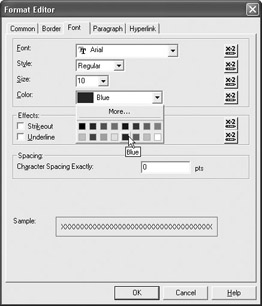
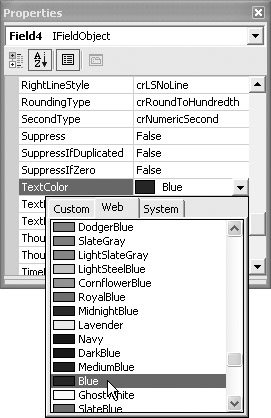
Format entire report sections (such as the Details section, Page Header, and so forth) by clicking the gray section title, right-clicking, and choosing options from the pop-up menu. In particular, you can perform all available section formatting by choosing Section Expert from the pop-up menu. This will display the Section Expert dialog box that allows control of suppression, page breaks, section background colors, and much more. Make desired choices and click OK. As mentioned previously, some of these changes ( especially conditional formatting formulas that you may supply) won t be visible until you run your application and see the report in a viewer.

| Tip | Formatting report objects is covered in Chapter 9. And, section formatting is covered in Chapters 9 and 10. Refer to these chapters for detailed information on report formatting techniques. |
Sorting and Grouping
While you can just display data records one after the other in the order the database supplies them, your reports become much more powerful if you at least sort the records in a meaningful fashion by one or more relevant fields. Do this by right-clicking on a blank area of the report designer and choosing Report Record Sort Expert from the pop-up menu. You can also click the Sort Order button in the Crystal Reports toolbar in the VS.NET IDE. The Sort Order dialog box will appear.
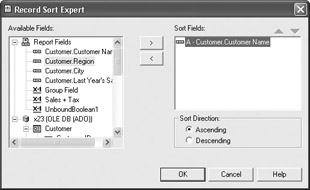
Select a desired sort field from the Available Fields list and click the right arrow to add it to the Sort Fields list. By default, the report will be sorted in ascending (A to Z) order. To change this order, select the desired field in the Sort Fields list and click the Descending radio button at the bottom of the dialog box. The report will be sorted by the chosen field in descending (Z to A) order. You are not limited to sorting the report on a single field ” add additional fields in the desired order, choosing ascending or descending sorts for each. If you need to change the priority of fields in the Sort Fields list, simply select the desired field and click the up or down arrow above the Sort Fields list to change the field s priority.
However, you may find that simply sorting the report doesn t provide sufficient flexibility for your needs. In many cases, report grouping is preferable to (or at least helpful in addition to) sorting. By creating report groups, you create level breaks that allow placement of summaries and subtotals at the end of each group. Furthermore, these grouping concepts, when used in concert with section formatting (typically, the hiding of report sections), become the basis for sophisticated drill-down reports that maximize the interactive capabilities of Crystal Reports placed in VS.NET applications.
To create a report group, right-click on a blank area of the report designer and choose Insert Group from the pop-up menu. You can also click the Insert Group toolbar button in the Crystal toolbars in the VS.NET IDE. The Insert Group dialog box will appear.

Choose the desired field on which you wish to group the report from the first drop-down list. Then, choose the order in which you want report groups to appear from the second drop-down list. If you wish to set additional group options, click the Options tab of the Insert Group dialog box and make choices. When you re finished, click OK to close the Insert Group dialog box and add the group to the report. You ll notice that group header and group footer sections appear in the report for your chosen group.
| Tip | Complete details on sorting and grouping are provided in Chapter 3. |
Once you ve created necessary report groups, you can insert summary and subtotal fields in the group footers for the groups (as well as grand totals in the Report Header or Report Footer). To insert a summary, you may optionally select the field in the Details section you wish to summarize (although you don t have to). Then, right-click the field you ve selected and choose Insert Summary from the pop-up menu. You can also click the Insert Summary toolbar button from the Crystal Reports toolbar in the VS.NET IDE (this button can be used even if you haven t selected a details field first). The Insert Summary dialog box will appear.
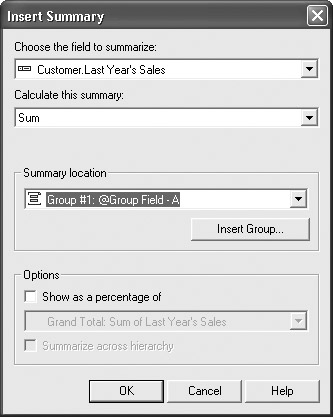
If necessary, choose the field you wish to summarize in the first drop-down list (the proper field should already appear in this list if you selected it first). Then, choose the desired type of summary (sum, average, count, and so forth) from the second drop-down list. In the third drop-down list, choose where you want the summary to be placed. Available options will be a grand total (placed in the report footer), or a subtotal placed in the desired group footer. If you wish to use a Percentage Summary Field or summarize across hierarchical groups (described in Chapter 3), check the appropriate boxes. When you click OK, the summary will be placed in the group footer or report footer.
| Note | While the user interface in the Integrated Report Designer differs somewhat from that in stand-alone Crystal Reports, the general techniques used to design reports are similar. While this chapter covers very general techniques for report design, Part I of this book covers report design techniques in much greater detail. Refer to chapters in Part I for information on various report design steps that also apply to reports designed with the VS.NET Integrated Report Designer. |
VS.NET Report Customization Object Models
While your application may not require any additional capabilities than are provided by a simple report bound to a viewer, there s a good possibility that you ll need to customize one or more aspects of the report at run time from within your application. These customizations can be as simple as supplying the user ID and password for a report s database connection from within your code (so that the user doesn t have to log in to the report s database again, after they ve already logged in to your application). Or, they may require more complex code that changes several report groups, formulas, parameter fields, formatting, or the report s record selection formula all on the fly based on other elements of your application.
Crystal Reports has always been the favorite of developers because of its flexible programming interfaces. And, the versions of Crystal Reports integrated with Visual Studio .NET carry on that tradition by providing rich object models that can control many aspects of report behavior at run time. Installing Crystal Reports 10 Developer or Advanced Developer editions after you ve installed VS.NET will improve on this programming flexibility even further.
There are two general ways of customizing your report at run time: using the Crystal Web Forms Viewer object model or using the Crystal Reports Engine object model. You should look at both object models, as well as your application requirements, to determine which object model you wish to use for run-time customization. Business Objects documentation discourages mixing object model usage ”particularly when changing the same properties in both object models. For example, you will probably encounter confusion (and, possibly application instability) if you, for example, change a parameter field using the Crystal Reports Engine object model, and then change the parameter again using the Crystal Web Forms Viewer object model before displaying the report in a viewer.
You ll notice that, in particular, the Web Forms Viewer object model is improved if you install one of the developer editions of Crystal Reports 10. It s quite possible that the viewer object model will provide all the necessary customization you need. However, certain complex reporting requirements that require more involved section formatting, run-time addition or removal of fields, groups, and so forth, will not be satisfied with the viewer object model. These will require use of the Crystal Reports Engine object model that can make significant run-time modifications to a report object before it is passed to a report viewer.
Run-Time Customization with the Crystal Web Forms Viewer
Some of the most obvious run time customization that you may wish to perform with the Crystal Web Forms Viewer is basic viewer appearance. You can, for example, control viewer properties at run time that you see in the Properties box at design time. In addition, commonly used report options, such as the report s record selection formula and parameter field values, can be changed at run time only with calls to the Crystal Web Forms Viewer object model.
These viewer object model choices are provided by assemblies installed with VS.NET and Crystal Reports 10. In particular, the CrystalDecisions.Web namespace is added as a reference to your project automatically when you add a Crystal Web Forms Viewer. This namespace exposes the object model available when using the viewer. When you install Crystal Reports 10 Developer or Advanced Developer editions on an existing computer containing Visual Studio .NET, this namespace is updated with additional version 10 capabilities.
Some initial customization you may wish to perform at run time simply involves viewer behavior, such as visibility of the group tree, appearance of individual toolbar buttons on the viewer toolbar, or complete invisibility of the entire toolbar. VS.NET intellisense technology will automatically show you available properties once you type the report viewer class, followed by a period. You can navigate through the various properties and, if necessary, see available arguments for available properties and methods .
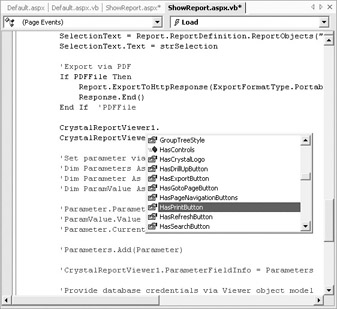
For example, the following code will hide the group tree in the viewer:
CrystalReportViewer1.DisplayGroupTree = False
And, more involved run-time customization to the viewer can involve instantiating additional objects, setting object properties, and passing the object to a viewer property to change viewer behavior. The following code will result in a group tree displaying an aqua background color and group tree entries in a bold coral color (this is an example of an improvement to the object model provided when you install Crystal Reports 10):
Dim GroupTreeStyle As New CrystalDecisions.Shared.GroupTreeStyle
With GroupTreeStyle
.BackColor = System.Drawing.Color.Aqua
.ForeColor = System.Drawing.Color.Coral
.Font.Bold = True
End With
CrystalReportViewer1.GroupTreeStyle = GroupTreeStyle
Notice the declaration of the GroupTreeStyle class, taken from the CrystalDecisions.Shared namespace. This namespace, also added to your project automatically when you add a Crystal Web Forms Viewer, provides an object model that exposes common objects and properties that can be used in both Crystal web and Windows applications. For example, this same GroupTreeStyle object could also be applied to the GroupTreeStyle property of the Crystal Windows Forms Viewer used in a Windows application.
| Note | The preceding example shows an object declaration with the fully qualified namespace. If you choose to add an Imports statement to import the namespace, then you would only need to declare the object using its class name without the need to precede it with CrystalDecisions.Shared. |
Other report properties not related to appearance can also be set with the Crystal Web Forms Viewer object model. Some of the most obvious are described in the sections that follow.
Specifying Database Credentials
If the report bound to the viewer is based on a secure database, the viewer will prompt for proper database credentials before displaying the report. If you have already gathered security information elsewhere in your application, you probably won t want your user to be prompted again. You can supply these credentials via the viewer object model as follows:
'Provide database credentials via Viewer object model
Dim Counter As Integer
For Counter = 1 To CrystalReportViewer1.LogOnInfo.Count
With CrystalReportViewer1.LogOnInfo(Counter - 1).ConnectionInfo
.ServerName = "SQLServer1"
.DatabaseName = "xtreme"
.UserID = "sa"
.Password = "password"
End With
Next Counter
This code loops through the individual ConnectionInfo objects within the report viewer s LogonInfo class, setting credentials for each. All database connections, regardless of original datasource, as well as subreport connection objects, will be included in the LogonInfo class. Accordingly, you ll need to take extra steps to properly assign values if the source tables in your main report or subreports come from different databases.
Modifying the Record Selection Formula
This is a very common requirement of report integration applications. You may wish to control report record selection based on some other control on a web form or another element of your embedded application logic. This is accomplished by setting the viewer s RecordSelectionFormula property.
'Set record selection via Viewer object model
If Countries = "USA Only" Then
CrystalReportViewer1.SelectionFormula = _
"{Customer.Country} = 'USA'"
Else
CrystalReportViewer1.SelectionFormula = ""
End If 'Countries = "USA Only"
Make sure you pass a valid record selection formula, using Crystal Reports Crystal Formula Syntax, to this property. Don t forget to include proper punctuation, such as French braces around field names and apostrophes around string literals. You may find discussions in Chapters 5 and 8 helpful in working with record selection formulas.
Supplying Parameter Field Values
In many cases, you may actually base your report s record selection on a parameter field. Or, perhaps you have created formulas based on parameter fields that change report grouping or formatting. In these cases, the ability to pass values to parameter fields at run time is crucial. Here s an example of passing a single value to a single-value (or discrete ) numeric parameter field:
'Set parameter via Viewer object model
Dim Parameters As New ParameterFields
Dim Parameter As New ParameterField
Dim ParamValue As New ParameterDiscreteValue
Parameter.ParameterFieldName = "Tax Rate"
ParamValue.Value = CDbl(5.25)
Parameter.CurrentValues.Add(ParamValue)
Parameters.Add(Parameter)
CrystalReportViewer1.ParameterFieldInfo = Parameters
Note that additional objects are instantiated to hold a parameters collection, a parameter field, and a parameter field discrete value. The parameter field name is supplied, using the parameter field s name in the underlying report. The actual discrete value for a 5-1/4 percent tax rate is supplied, including a cast to ensure proper data type matching. The discrete value object is added to the parameter s CurrentValues collection. The parameter is added to a parameters collection. And finally, the viewer s ParameterFieldInfo property is set to the parameter s collection.
Web Forms Viewer Events
Not only can you set report viewer properties at run time, but you can also trap report viewer events. As Crystal Reports blends into the entire .NET framework and ASP.NET event processing, you can trap viewer events in the Crystal Web Forms Viewer and add code based on them. By selecting the desired Web Forms Viewer in the Class Name list in the code window, you ll then be able to see a list of events that the viewer fires in the Method Name list.
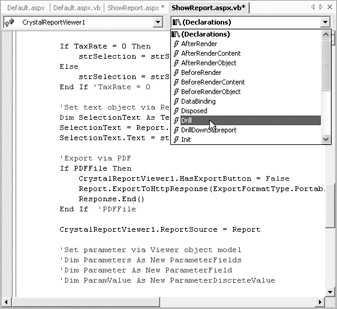
You may, for example, add code that traps a viewer drill-down event and performs some action based on the group that is drilled into.
Private Sub CrystalReportViewer1_Drill(ByVal source As Object, _
ByVal e As CrystalDecisions.Web.DrillEventArgs) _
Handles CrystalReportViewer1.Drill
If e.NewGroupName = "USA" Then
e.Handled = True
End If
End Sub
In this example, the event class exposes DrillEventArgs from the CrystalDecisions.Web namespace, including various properties to indicate what is being drilled into. Here, the code checks to see if the USA group is being drilled into. If so, the drill-down is canceled by setting the class s Handled property to True.
Run-Time Customization with the Crystal Reports Engine
So far, this chapter has concentrated entirely on run time customization with the Crystal Web Forms Viewer object model (with classes exposed by the CrystalDecisions.Web namespace) and the shared object model (with classes exposed by the CrystalDecisions.Shared namespace). There s still yet another object model/namespace that exposes classes you can use to customize report behavior at run time.
By using the Crystal Reports Engine object model, you can customize report behavior at run time using techniques similar to those discussed previously in the chapter. However, this object model (exposed by the CrystalDecisions.CrystalReports.Engine namespace) offers properties, methods, and events that are strictly limited to the core report object you are integrating in your application, independent of any viewer you may have added to your application. Also, a much larger number of customization options are available with the Report Engine. In addition to setting parameter field values, supplying database credentials, and setting the report s record selection formula, the Report Engine offers the ability to control object formatting, supply new formula contents, export the report to various file formats, and much more.
Any customization you perform here typically takes place before you bind a report to a viewer (or, in situations where you don t even add a viewer to your project). Once you ve made these customizations to the report object, they will take effect when the report is bound to the viewer (or, in the case of a non-viewing application, whenever you execute a report method to ultimately output the report to a printer, exported file format, and so forth).
As discussed earlier in the chapter, you ll find properties and methods in the Report Engine that duplicate those found in the viewer object model. For example, you can supply database credentials, set the record selection formula, and supply parameter field values via either object model. The decision as to which object model to use is dependent upon your application particulars and how detailed your integration requirements are. Again, Business Objects recommends that you avoid duplicate calls from different object models in the same application. So, as you develop your application, look at which object model provides the best combination of simplicity and functionality depending on your requirements.
To make use of the Report Engine, you must ensure that the CrystalDecisions.CrystalReports .Engine namespace is being referenced in your project. In most cases, you ll also need references to the CrystalDecisions.Shared namespace. Typically, if you add a Crystal Web Forms Viewer to the project, these namespaces will automatically be added. If, however, you are designing an application that does not make use of a Web Forms Viewer, you ll need to use the VS.NET Add Reference option to add these namespaces to your project. Also, you ll need to declare references to several classes from these namespaces in your code and may prefer to use the Imports statement to allow class references without the fully qualified namespace name.
One of the first requirements of using the Report Engine is instantiation of a report object. As discussions earlier in the chapter indicate, there are several ways of adding reports to your project. And, there are several types of reports (untyped, strongly typed, and so forth) that can be added. As an example, you may have added a strongly typed report to your project, either by using Add Add Existing Item with an existing .RPT file or by using Add Add New Item and designing a new Crystal Report. You then must declare an object to refer to the strongly typed report and expose the Report Engine s object model. Here s an example:
Dim Report As New Last_Years_Sales
'refers to strongly-typed Last Year's Sales.rpt in project
Once you ve declared this object, you will notice many of the Report Engine properties and methods available via VS.NET s Intellisense technology.
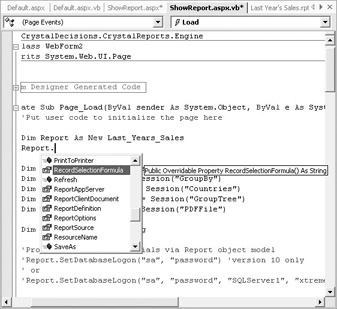
Some of the more common run-time customizations you can make with the Report Engine (but, by no means, an exhaustive list) include:
Supplying Database Credentials
If your report is based on a secure database, you will probably prefer that your application code provide database credentials to prevent your report viewer from being prompted, or from your application failing if your report is not bound to a viewer. There are several ways for the Report Engine to supply these credentials. Examine the following:
'Provide database credentials via Report object model
Report.SetDatabaseLogon("sa", "password")
This single line of code supplies a user ID and password to every datasource in the report, including those contained in subreports. The SetDatabaseLogon method greatly simplifies supplying database credentials if your report is based entirely on a single database connection.
A second permutation of SetDatabaseLogon accept four arguments:
Report.SetDatabaseLogon("sa", "password", "SQLServer1", "xtreme") This allows a database server and database name to also be specified, in case you ve made use of several different connections in your report.
If you need a more granular way of supplying database credentials for individual table objects in your main report and subreports, you ve got a little more coding ahead of you. Examine the following:
Dim Logon As New TableLogOnInfo
Dim Tbl As Table
For Each Tbl In Report.Database.Tables
Logon = Tbl.LogOnInfo
Logon.ConnectionInfo.ServerName = "SQLServer1"
Logon.ConnectionInfo.DatabaseName = "xtreme"
Logon.ConnectionInfo.UserID = "sa"
Logon.ConnectionInfo.Password = "password"
Tbl.ApplyLogOnInfo(Logon)
Next Tbl
'Provide database credentials to subreports
Dim Subreport As ReportDocument
For Each Subreport In Report.Subreports
For Each Tbl In Subreport.Database.Tables
Logon = Tbl.LogOnInfo
Logon.ConnectionInfo.ServerName = "SQLServer1"
Logon.ConnectionInfo.DatabaseName = "xtreme"
Logon.ConnectionInfo.UserID = "sa"
Logon.ConnectionInfo.Password = "password"
Tbl.ApplyLogOnInfo(Logon)
Next 'Tbl
Next 'Subreport
In the preceding code fragment, a TableLogonInfo class (from the CrystalDecisions.Shared namespace) and Table class (from the CrystalDecisions.CrystalReports.Engine namespace) are instantiated. Then, each table in the main report is cycled through, supplying database credentials via the ConnectionInfo property.
To accommodate subreports, a ReportDocument class is instantiated (this comes from CrystalDecisions.CrystalReports.Engine), which is used to cycle through the main report s Subreports collection. For each subreport, similar loops through the Database.Tables collection are made to supply database credentials.
While the preceding code will work with Crystal Reports 10, earlier versions (including Crystal Reports included with VS.NET) do not expose a Subreports collection. In this situation, code to deal with subreports must be even more granular, as the following example shows.
crSections = Report.ReportDefinition.Sections
For Each crSection In crSections
crReportObjects = crSection.ReportObjects
For Each crReportObject In crReportObjects
If crReportObject.Kind = ReportObjectKind.SubreportObject Then
crSubreportObject = CType(crReportObject, SubreportObject)
subrpt = _
crSubreportObject.OpenSubreport(crSubreportObject.SubreportName)
For Each subtbl In subReport.Database.Tables
str &= subReport.Name & "-" & subtbl.Name & " - "
objTableLogonInfo = subtbl.LogOnInfo
objTableLogonInfo.ConnectionInfo = objConnInfo
subtbl.ApplyLogOnInfo(objTableLogonInfo)
subtbl.Location = _
subtbl.Location.Substring(subtbl.Location.LastIndexOf(".") + 1)
str &= subtbl.TestConnectivity() & vbCrLf
Next
End If
Next
Next
Setting Record Selection
As with the viewer object model, you can set the report s record selection formula at run time via a simple property setting in the Report Engine. You will probably want to do this in terms of other controls or conditions in your application. For example:
Report.RecordSelectionFormula = "{Customer.Country} = 'USA'" will return records where the country is USA. Ensure that you pass a syntactically correct formula using the Crystal Reports Crystal Syntax, including French braces around field names and apostrophes surrounding string literals. Discussions on record selection and formula syntax can be found in Chapters 5 and 8 in this book.
Modifying Existing Formula Contents
One area of report customization that can only be accomplished with the Report Engine is run-time report formula modification. For example, you may wish to change some sort of calculation or string customization contained in a report formula based on a user control or other element of your custom application. By modifying a report formula at run time, you can change report calculations or customized fields based on your application elements. For example:
If GroupBy = "Country" Then
Report.DataDefinition.FormulaFields("Group Field").Text = _
"{Customer.Country}"
Else
Report.DataDefinition.FormulaFields("Group Field").Text = _
"{Customer.Region}"
End If 'GroupBy = "Country"
You may navigate directly to the FormulaFields collection of the report s DataDefinition object. Notice that the particular collection member can be retrieved by name, in addition to numeric index (this is a refreshing change from many collections in the older Report Designer Component, which could only be accessed via numeric index). By setting the formula s Text property, you can change the formula contents at run time. In this example, a variable is examined indicating the user s grouping choice. Report grouping is being controlled via a formula which is set to the database field corresponding to the user s choice. Note that you must supply a formula of proper syntax when setting the Text property. Chapter 5 discusses report formulas in greater detail.
Providing Parameter Field Values
A very common requirement of run time report modification is dealing with parameter fields. As many report customizations can be accomplished by designing reports with parameter fields, you may find this one of the most common run time modifications you ll be required to perform. While the viewer object model can change parameter field values at run time, you may prefer (or be required) to use the Report Engine to supply parameter values at run time. If you have installed Crystal Reports 10, the report object s SetParameterValue method is a simple way to supply a value to a parameter field:
'Set parameter via Report object model
Report.SetParameterValue("Tax Rate", TaxRate)
The SetParameterValue method demonstrated here accepts two arguments: the parameter field to supply a value to (which can be specified either by name or index), and the value to pass to the parameter field (in this instance, a variable that has been cast elsewhere in the code to match the data type of the parameter field).
The SetParameterValue method is fairly flexible in the data types and parameter field types (such as multi-value parameter fields) that it can accommodate. It can also be used to supply parameter values to subreports. The Crystal Reports 10 help collection contains complete details.
If you have more complex parameter requirements that may not be accommodated by the SetParameterValue method, you may modify parameters via an additional object. Here s an example that sets a simple, single-value parameter field:
Dim ParamValue As New ParameterDiscreteValue
'CrystalDecisions.Shared.ParameterDiscreteValue if no Imports
ParamValue.Value = TaxRate
Report.ParameterFields("Tax Rate").CurrentValues.Add(ParamValue)
A discrete parameter class is instantiated to hold a single discrete (single-value) parameter field. The object s Value property is set to a variable (again, properly cast earlier in the code). And, finally, the parameter object is added to the existing parameter field s CurrentValues collection (which, for a single-value parameter field, will only contain one member). The parameter field can be obtained from the report s ParameterFields collection, either by name or by numeric index.
Supplying Text Object Text
While there are several ways to display a custom string or message on a report (perhaps you wish to display various run time options chosen by the report viewer on the report itself), one way is to set the actual text displayed by a text object at run time. This capability is provided by the Report Engine only and cannot be accomplished by using any of the viewer object model calls. Here s an example:
'Set text object via Report object model
Dim SelectionText As TextObject
'CrystalDecisions.CrystalReports.Engine.TextObject if no Imports
SelectionText = Report.ReportDefinition.ReportObjects("SelectionText")
SelectionText.Text = strSelection
Instantiate a TextObject object (supplied by the CrystalDecisions.CrystalReports.Engine namespace). Set it to a proper text object in the report by navigating through the report s ReportObjects collection from the ReportDefinition object. Then, set the text object s Text property to change the actual text contained in the text object on the report.
Exporting Reports in Web Applications
While the Crystal Web Forms Viewer includes an Export toolbar button that allows the viewer to export the viewed report to various file formats, you may wish to do this programmatically. You may, for example, prefer to limit the formats that the report may be exported to and not allow the viewer to export with the toolbar button. You might, then, disable the export button in the viewer and export the file to a specified format within code. Examine the following:
CrystalReportViewer1.HasExportButton = False
Report.ExportToHttpResponse(ExportFormatType.PortableDocFormat, _
Response, False, "") 'Crystal Reports 10 only
Initially, the viewer s export toolbar button is hidden. Then, the report object s ExportToHttpResponse method is used to export the file via the Response object in Acrobat PDF format. There are several versions of this method with arguments documented in the Crystal Reports 10 help collection. Note that this particular approach is only supported by the version 10 CrystalDecisions.CrystalReports.Engine namespace ”if you are using the original out-of-the-box installation of Crystal Reports in VS.NET, you ll need to undertake a more involved export process whereby you export to a local file on the web server and then stream the file to the web browser.
| Tip | Additional Crystal Reports Engine object model examples can be found in Chapter 28. This covers VS.NET Crystal Reports integration with Windows applications. |
Crystal Reports as XML Web Services
One of the new features of Visual Studio .NET is the web service: a web server “based application that exposes a set of data based on the Extensible Markup Language, or XML. The web service exposes its actual data, as well as its data layout (or schema), through the Hypertext Transport Protocol, or HTTP. Because the XML data layout is simply an extension of HTML and because HTTP is such a ubiquitous communications protocol, virtually all networks, intranet systems, and Internet connection methods (dial-up, firewalls, and so forth) work with these standards already.
Crystal Reports for Visual Studio .NET fully supports web services ”being able to both create and consume web services. Creating a web service based on a Crystal Report exposes a report via HTTP to anyone who can consume a web service anywhere on an intranet or the Internet. VS.NET also allows you to create projects that use or consume published Crystal Report web services. In this scenario, you create a Windows or web application, including a Windows Forms Viewer or Web Forms Viewer, which is then bound to the report exposed by the web service.
| Note | Consuming web services in VS.NET web applications is covered later in this chapter. Consuming web services in VS.NET Windows applications is covered in Chapter 28. |
Creating a Web Service
Creating a web service based on a Crystal Report is a very straightforward process ”almost identical to creating a web application using a Crystal Report. You must establish a location (by way of a virtual directory) on the web server that you want to use to host the web service. You can do this either by using an existing web application to host the web service or by creating a new ASP.NET Web Service (if all you want to do is host reports in a web service, just create a Web Service, not a Web Application). The web application or web service creation will create the virtual directory with the same name as the service or application.
Once you ve opened or created your web service or web application project, add a strongly typed Crystal Report the same way you would for another application. Use Add Add Existing Item and navigate to the desired existing .RPT file, or use Add New Item and create a new .RPT file from scratch. You may make any design changes and customization to the report in the Integrated Report Designer inside the VS.NET IDE the same as you would for any other report.
| Caution | Life will be much easier if you add or create a report that doesn t contain any spaces in the filename. If necessary, rename the report in the Solution Explorer, removing or replacing spaces. |
When you re ready to post the report on a web server as a web service, simply right- click the report object in the Solution Explorer that you want to publish. Choose Publish as Web Service from the pop-up menu.
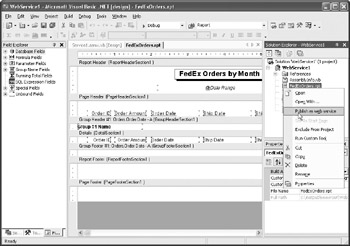
Additional files representing the web service will be created in the Solution Explorer. In particular, an .asmx file (with the word Service appended to the report name) will appear ” this is actually the web page that exposes the web service. Also, a language-specific version of the .asmx file (with an appended .vb, for example) will also be created. You ll need to click the Show All Files button in the Solution Explorer to see it. This may be used to add additional custom code to your web service, if you choose.
To actually post the Crystal Report web service on the web server that the web service project was created on, you must compile the application. Choose Build Build Solution from the VS.NET pull-down menus , or right-click on the solution name in the Solution Explorer and choose Build Solution from the pop-up menu.
Consuming Web Service Reports in a Web Application
Once a web service has been created and compiled, you can actually use a web browser to view the properties of the web service. The URL is based on the application or web service you used to publish the report, and the report name. For example, if you created a default web service name of WebService1, and published a report named FedExOrders.rpt, an FedExOrdersService.asmx file will be created in the WebService1 virtual directory. If you type in the following URL in a standard web browser:
http://< server name >/WebService1/FedExOrdersService.asmx
you ll see the properties exposed by the report web service. You may click various hyperlinks on this page to see the underlying XML that the web report service exposes, but the report will not be viewable in the browser directly using this URL.
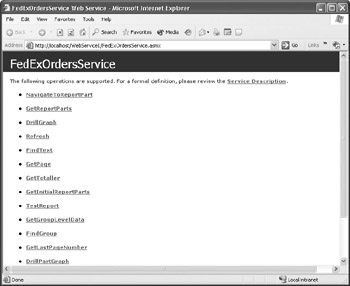
In order to view or consume a report web service, you must create another web application and add a Crystal Web Forms Viewer to it. You must then bind the Web Forms Viewer to the report exposed by the report web service. As you might expect, there are several ways to reference a report web service in your web application and bind the Web Forms Viewer to it.
Binding by URL as the ReportSource
Select the Crystal Web Forms Viewer you ve added to your web form. Then, click the ellipses next to the DataBindings() property in the Properties box. This will display the DataBindings dialog box for the Web Forms Viewer. Click the ReportSource property in the Bindable Properties list and then click the Custom Binding Expression radio button. Type the full URL to the report web service (including the http:// protocol string), surrounded by quotation marks.
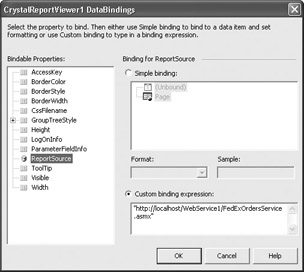
Binding by Adding the Report Web Service as a Reference
You may also add a reference to the web report service to your web project and instantiate a copy of any reports exposed by it. To do this, perform the following steps.
-
Add a reference to the web service by clicking the References category of the Solution Explorer. Right-click the References category and choose Add Web Reference from the pop-up menu. The Add Web Reference dialog box will appear.
-
In the Address line of the Add Web Reference dialog box, type the full URL for the web service. For example, to add a reference to the FedExOrders report web service discussed previously, type:
http://localhost/WebService1/FedExOrdersService.asmx
-
You ll see the same web browser display you would see if you navigated to the URL in a standard web browser. Also, a list of all exposed report web services will appear in the box on the right of the dialog box. And, the web server name will appear as the default name for the reference. If you wish to reference the web server by a different name, type it in the Web Reference Name text box. When you re finished, click OK to add the report web services as references.
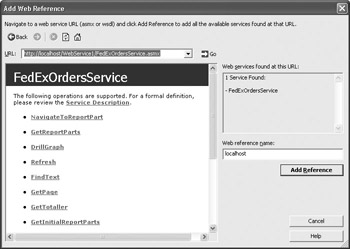
To reference the web service in the Web Forms Viewer, you may execute code similar to the following in the Load event of the form containing the viewer:
CrystalReportViewer1.ReportSource = _
New localhost.FedExOrdersService
When you run the application, the report exposed by the web service will appear in the form containing the viewer.
Setting Viewer Properties with Consumed Web Services
The actual report exposed by the report web service isn t strongly typed. For this reason, you don t have the same control you do over a strongly typed report making use of the Report Engine namespace. However, you can still manipulate the report with classes exposed by the Crystal Web Forms Viewer (you have a much richer set of choices if you ve installed Crystal Reports 10 Developer or Advanced Developer editions).
For example, you can still make use of viewer properties to provide database credentials, set the record selection formula, or supply parameter field values. For example, the following code will supply beginning and ending dates to a date range parameter field included in the report exposed by the report web service.
Dim Parameters As New CrystalDecisions.Shared.ParameterFields
Dim Parameter As New CrystalDecisions.Shared.ParameterField
Dim ParamValue As New CrystalDecisions.Shared.ParameterRangeValue
Parameter.ParameterFieldName = "Date Range"
ParamValue.StartValue = #1/1/2002#
ParamValue.EndValue = #12/31/2002#
Parameter.CurrentValues.Add(ParamValue)
Parameters.Add(Parameter)
CrystalReportViewer1.ParameterFieldInfo = Parameters
Distributing Crystal Reports ASP.NET Web Applications
Once you ve designed your Crystal Reports ASP.NET web application, you need to place it on the production web server for use by web viewers. If you happened to install Visual Studio.NET and Crystal Reports 10 on the target web server, then you may need to do nothing more than distribute the URL for your application to end users, or place a link containing the URL on another portal or home page.
However, if you need to distribute the ASP.NET web application to a different web server than it was designed on, you have varying amounts of work ahead of you. You could perform a complete install of Visual Studio .NET and Crystal Reports 10 Developer or Advanced Developer on the target server and then simply copy files from the virtual directory. Or, you could create a typical Setup and Deployment project using standard VS.NET steps to create a Microsoft Installer package to install the web application on the target web server.
When deploying ASP.NET web applications that contain Crystal Reports, keep the following general concepts in mind:
-
The target machine must contain the .NET Framework Depending on how you create your setup project, you may not include the .NET Framework files in the setup routines. Because Crystal Reports for VS.NET fully integrates with the .NET Framework, you ll need to ensure it is installed on the web server before installing your Crystal web application.
-
You will need Business Objects “supplied merge modules If you have installed Crystal Reports 10 Developer or Advanced Developer edition on your development machine, you ll need to distribute updated Crystal Reports 10 modules with your application. This is accomplished by using one (and, if you are embedding geographic maps in your report, an additional) merge module when you build your setup project.
Download the Crystal Reports 10 merge modules from http://support .BusinessObjects.com/MergeModules. You ll find included documentation that specifies what object models, viewers, and features are included with the various merge modules.
If you are using the version of Crystal Reports that ships with Visual Studio .NET, merge modules are found in \Program Files\Common Files\Merge Modules.
-
Don t forget the keycode When developing your reporting application, you may have noticed a Crystal screen prompting you to register your copy of Crystal Reports for VS.NET. This appears whether you are using the copy of Crystal Reports included with VS.NET, or if you ve installed Crystal Reports 10 afterwards (and, sometimes even if you ve registered your stand-alone copy of Crystal Reports).
While you can bypass this screen when developing your application, you won t be so lucky when it comes time to distribute it. If a valid Crystal keycode isn t specified when you build your setup program, your distributed application won t work. You may obtain the necessary keycode by following the steps in the registration prompt (you ll be taken to the Business Objects web site and asked to supply various pieces of personal information). Once you re finished with registration, you can display the keycode by choosing Help About Microsoft Development Environment from the VS.NET menus. Note the three part keycode that appears next to the Crystal Reports entry in the list. Either write it down or select the Crystal Reports entry and click the Copy Info button to copy the keycode to the Windows clipboard.
When you build your setup project, you must select the primary Crystal Reporting merge module and paste the keycode into the Keycode Properties box.
| Note | If you installed Crystal Reports 10 Developer or Advanced Developer editions, your keycode should be the same keycode on the program CD that you used when you installed stand-alone Crystal Reports 10. |
EAN: N/A
Pages: 223